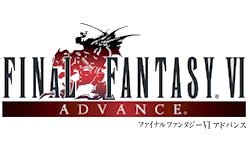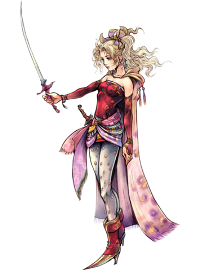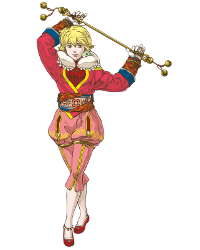
Terra Branford  Terra and her quest to determine whom she is as an individual — a slave? a murderer? a monster? a person? — drive Final Fantasy VI's plot more than any other member of the cast. The answers aren't easy. Her mother is dead. Her father, an esper, was tortured and killed by the same people who enslaved her. Pushed by events outside of her control throughout the first half of the game, the second half sees her maturing into adulthood. Running a town full of orphans, providing parentless children the safety she desperately needed as a child, giving them the life that was stolen from her at that age, Terra's love for others and giving nature show she is neither a slave nor a murderer. Her individuality shines when she's one of the few cast members who doesn't immediately rejoin the party. Her love widens in the realization that her orphanage is local, but suffering is global, and that joining forces with others will increase her ability to help. Terra and her quest to determine whom she is as an individual — a slave? a murderer? a monster? a person? — drive Final Fantasy VI's plot more than any other member of the cast. The answers aren't easy. Her mother is dead. Her father, an esper, was tortured and killed by the same people who enslaved her. Pushed by events outside of her control throughout the first half of the game, the second half sees her maturing into adulthood. Running a town full of orphans, providing parentless children the safety she desperately needed as a child, giving them the life that was stolen from her at that age, Terra's love for others and giving nature show she is neither a slave nor a murderer. Her individuality shines when she's one of the few cast members who doesn't immediately rejoin the party. Her love widens in the realization that her orphanage is local, but suffering is global, and that joining forces with others will increase her ability to help.
There was always an interesting point of Terra's drive for me, though, in that only she had something to lose by saving the world. For her, the trip to Kefka's tower was one made as a martyr; defeating Kefka would save the world and all the children in it, but kill her. Terra bore this burden with confidence and dignity, unlike so many other martyrs in tales. It's a point of contrast between the two lady leads: Celes saw a devastated world and stood on a cliff, depressed and alone, contemplating suicide out of hopelessness until a sign changed her mind. Terra's willingness to face death at the end of Final Fantasy VI was in the company of friends, for the betterment of others, and motivated by hope. She had survived an unimaginably horrible childhood to become one of gaming's most powerful, compassionate, and self-actualized characters, lady or otherwise. — Glenn Wilson

Tetra  Tetra is not your ordinary Princess Zelda. She's crass, adventurous, and also the captain of a surly group of pirates three times her age and size. Her first encounter with Link occurs after she fights off a giant bird that's trying to fly off with her in mid-air, after which she proceeds to take him aboard her ship, where she promptly makes him the subordinate of the lowest ranking cabin boy on her crew. Later she fires him out of a cannon. Tetra is not your ordinary Princess Zelda. She's crass, adventurous, and also the captain of a surly group of pirates three times her age and size. Her first encounter with Link occurs after she fights off a giant bird that's trying to fly off with her in mid-air, after which she proceeds to take him aboard her ship, where she promptly makes him the subordinate of the lowest ranking cabin boy on her crew. Later she fires him out of a cannon.
Tetra is everything the typically portrayed Princess Zelda is not: directly involved. She is one of only a handful of Zeldas that actually fights Ganon alongside Link, and the only one to appear in more than a single game. In Phantom Hourglass, she ends up trapped in an alternate dimension because she just had to go explore that ghost ship — an impressively courageous display, but ironically unwise for someone bearing the Tri-Force of Wisdom. According to the lore of Spirit Tracks, her crew eventually went on to discover an entire continent!
Tetra is every bit as brave and adventurous as Link, and her witty repertoire and take-no-guff attitude makes her the best Princess Zelda of them all. Yes, even better than Sheik. — Adriaan den Ouden

Totooria Helmold (Totori)  Of all the Atelier heroines to date, none have ever surpassed my love and admiration for Totori. This may because in playing Aterlier Totori, I found myself doing a lot of self-reflection as the story unfolded. Totori is a young woman who has never left her village, but when her mother never returns home from an expedition, our heroine decides she must leave home to locate her whereabouts. Of all the Atelier heroines to date, none have ever surpassed my love and admiration for Totori. This may because in playing Aterlier Totori, I found myself doing a lot of self-reflection as the story unfolded. Totori is a young woman who has never left her village, but when her mother never returns home from an expedition, our heroine decides she must leave home to locate her whereabouts.
What I love about Totori is the fact that she has constant growth throughout the story. At the beginning she's timid, afraid to leave home because she's always clung to the safety of her village, and evolves into this fearless young woman who knows she must grow up and take charge of her destiny. The best part is that this transformation isn't abrupt, but rather it's a gradual process. Totori is trying to figure out her own self-identity, and her drive and determination to become someone stronger both in body and spirit is something I connected with, and applauded her efforts. Sure, she's the least crazy of the Atelier heroines, but her emotional growth is easily the main reason why you should play Atelier Totori. — Sam Wachter

Xelha  There are characters who break the mold of their archetype and there are others who crack it. Xelha seems to be in many ways a typical RPG heroine. She is soft-spoken, kindly, modest, a magic-user, falls in love with the main character, carries a plot-important pendant, is secretly royalty (who wears pink nonetheless), and has a tragic destiny. Indeed, while I never disliked Xelha, I didn't think much of her until the midpoint of the game, where the Guardian Spirit forms a bond with her until Kalas returns. It is at this time that her true strength and will comes out. Despite being captured and only with the Spirit as her companion, she is able to rescue her friends, rally the nations to stop the wicked god Malperco, and save Kalas from becoming part of the dark god's forces and being killed along with it. Xelha, as it turns out, is not some rebellious princess, but a queen and rightful ruler of the nation of Wazn. She is certainly not meek, often being the first to call out Kalas on his callousness. Baten Kaitos arguably centers around her just as much as it does Kalas. There are characters who break the mold of their archetype and there are others who crack it. Xelha seems to be in many ways a typical RPG heroine. She is soft-spoken, kindly, modest, a magic-user, falls in love with the main character, carries a plot-important pendant, is secretly royalty (who wears pink nonetheless), and has a tragic destiny. Indeed, while I never disliked Xelha, I didn't think much of her until the midpoint of the game, where the Guardian Spirit forms a bond with her until Kalas returns. It is at this time that her true strength and will comes out. Despite being captured and only with the Spirit as her companion, she is able to rescue her friends, rally the nations to stop the wicked god Malperco, and save Kalas from becoming part of the dark god's forces and being killed along with it. Xelha, as it turns out, is not some rebellious princess, but a queen and rightful ruler of the nation of Wazn. She is certainly not meek, often being the first to call out Kalas on his callousness. Baten Kaitos arguably centers around her just as much as it does Kalas.
What I find most fascinating about Xelha is how she handles her destiny. She doesn't want to run away from her station, nor does she give herself over to her duties without a challenge. She understands how important her task is, but she also doesn't want to be remembered by history in some vague, grand way. She wants to make a deeper connection to a few people and change someone's life on a personal level. These people would turn out to be the party members, especially Kalas, someone she comes to recognize as a kindred spirit. — Cassandra Ramos
« Page 4 | Beginning »
|









